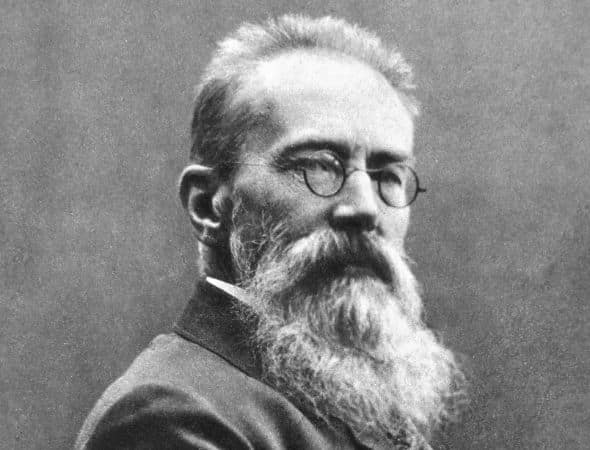RIMSKY-KORSAKOV: Scheherazade
by Jeff Counts
THE COMPOSER – NIKOLAI RIMSKY-KORSAKOV (1844-1908) – Rimsky-Korsakov had no opera projects in the queue during the 1887-88 season, so he was able to focus on orchestral composition. The three successive works he created during that time – Capriccio espangol, Op. 34, Russian Easter Overture, Op. 36 and Scheherazade, Op. 35 – would eventually bring him international symphonic fame, but Rimsky-Korsakov made no effort to capitalize on it. He was an opera man, through and through, and was already well on his way to falling under the spell of Richard Wagner. The trio of orchestral 1887/88 showpieces, however successful, would soon be part of a closed chapter for the composer.

THE HISTORY – Regarding the story at the heart of Scheherazade, Rimsky-Korsakov’s evocative tribute to storytelling, the composer himself set the following stage: “The Sultan Shahriar, convinced of the falseness and faithlessness of all women, vowed to slay each of his wives after their first night with him. But the Sultana Scheherazade saved her life by arousing his interest in tales which she told him over one thousand and one nights. Driven by curiosity, the Sultan put off her execution from day to day, and at last gave up his bloody resolution altogether.” For this scenario, Rimsky-Korsakov was drawing on very old material indeed. The Thousand and One Nights (or Arabian Nights) are a collection of stories variously credited to Persian, Indian and Arabic sources. All those cultures likely contributed, and more, making the Nights a kind of secular bible. References go back as far as the 10th century but the oldest complete manuscript dates from Syria in the 14th century. Frenchman Antoine Galland made a “modern” version of the collection in the early 1700s and it was this retelling that inspired Rimsky-Korsakov. He might not have had an opera of his own in the works during the winter of 1887, but he was working hard to complete Alexander Borodin’s Prince Igor at the time. Borodin had died suddenly the previous February and though Rimsky-Korsakov took the efforts on behalf of his departed friend seriously, he couldn’t ignore the call of his own sirens. He created four loosely referential adventures to inform his Scheherazade. The orchestral fury of the Sultan and the solo violin enchantments of Scheherazade herself are literal enough, but the rest was never supposed to be. “I meant these hints,” he wrote of his movement titles, “to only slightly direct the hearer’s fancy…”. The staggering instrumental color he employed throughout obviated the need for narrative detail in any case, leaving plenty of freedom for the “hearer” to visualize the “numerous and varied fairy-tale wonders” of the score.
THE WORLD – Elsewhere in 1888, The National Geographic Society was founded, the Concertgebouw was inaugurated in Amsterdam, Vincent Van Gogh famously removed a portion of his ear and Jack the Ripper’s first victim was discovered in Whitechapel.
THE CONNECTION – Scheherazade is a frequently programmed work in Utah Symphony history. The last time occurred in May 2017 under Kazuki Yamada.












